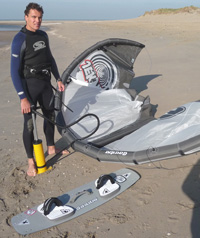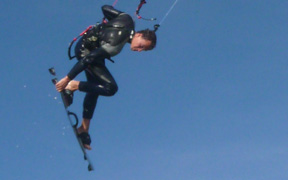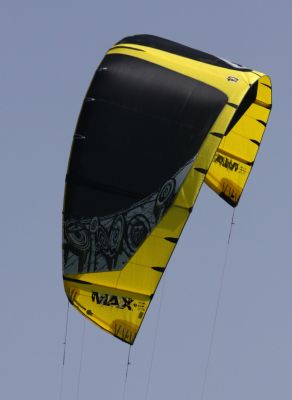Again we have added content to the site. You can find this and other information about our great sport via the navigation bar above. Bigger & better every day!
These are the kites most used by kiteboarders. Most kitesurf lesson schools give kitesurfing lessons with these types of kites.
Bow and SLE kite recognition
 Due to the inflated frame, which the kiteboarder inflates itself, the kite can easily be restarted from the water. The Leading Edge is the largest horizontal tube at the top of the kite. This runs down on the outside of Bow kites and SLE kites. You can see this clearly when the kite is on the ground, the ends of the kite (wingtips) come off the ground. Bridles, so-called 'bridles', are attached to the Leading Edge. These bridles ensure that the Leading Edge retains its shape during kiteboarding.
Due to the inflated frame, which the kiteboarder inflates itself, the kite can easily be restarted from the water. The Leading Edge is the largest horizontal tube at the top of the kite. This runs down on the outside of Bow kites and SLE kites. You can see this clearly when the kite is on the ground, the ends of the kite (wingtips) come off the ground. Bridles, so-called 'bridles', are attached to the Leading Edge. These bridles ensure that the Leading Edge retains its shape during kiteboarding.
Purpose of Bow and SLE kites
The goal behind the development of Bow and SLE kites is safety. It must be the case that the moment the kiteboarder releases his control stick ('bar'), the Bow and SLE kites lose all their power. This principle is called 'extreme depowering' of the kite.
Features, benefits and focus
 Bow and SLE kites are more efficient in terms of shape than the original C-shape kites. With this, Bow and SLE kites deliver more power per m2 surface area of cloth. As a result, a Bow or SLE kite that is smaller than the C-shape kite can provide the same power build-up as the C-shape kite of a size larger.
Bow and SLE kites are more efficient in terms of shape than the original C-shape kites. With this, Bow and SLE kites deliver more power per m2 surface area of cloth. As a result, a Bow or SLE kite that is smaller than the C-shape kite can provide the same power build-up as the C-shape kite of a size larger.
Bow and SLE kites also have a larger wind range than the C-shape kites, so that the kiteboarder does not have to change kite as quickly in changing weather conditions.
This brings us to the balance point of the Bow and SLE kites. After reading this text you might think that if you have one Bow or SLE type of kite, you can kite surf at all winds. However, this is not the case and ultimately also comes at the expense of kite fun and safety. The kite becomes less controllable and controllable with extreme depower, which makes kite surfing no more fun and safer. So always inquire about the prescribed wind range of the kite.





Perhaps it is useful to mention that if you do not have much experience yet, every new kite first tests in wind force 3 to 4 and no more. Then you run much less chance of any problems and you can still work out relatively safely if you run into a problem.